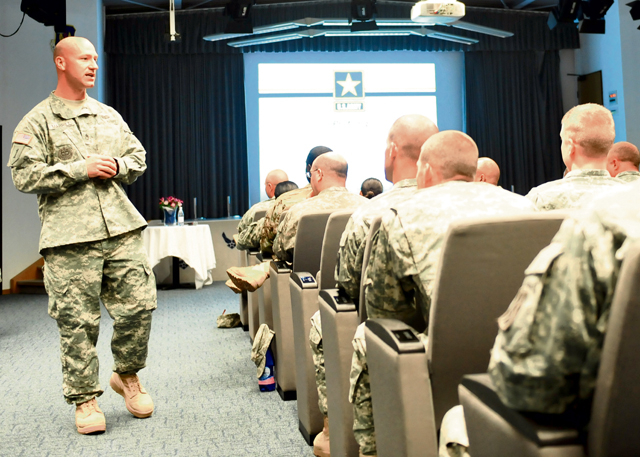
Leaders are gathering in classrooms and training sites all across Europe for one simple reason: change is coming. Trained instructors make their rotations among U.S. Army Europe units to bring valuable news about an updated system: the new Noncommissioned Officer Evaluation Report.
NCOs from the 21st Theater Sustainment Command traveled throughout the U.S. European Command’s footprint to conduct training on changes and the new requirements associated with the new NCOER.
The 21st TSC headquarters has three NCOs currently conducting “train the trainer”-style instruction on the new evaluation system. Their class, which takes four hours to complete, addresses complications inherent with the old NCOER and how the new system corrects these issues. The most recent 21st TSC-hosted class took place
July 15 at Kapaun Air Station with instructing leaders from the 19th Battlefield Coordination Detachment, 10th Army Air and Missile Defense Command, 18th Military Police Brigade, Landstuhl Regional Medical Center, 16th Sustainment Brigade and other Kaiserslautern-based units.
“The new evaluation system brings a significant element of change with it,” said Sgt. 1st Class Patrick B. Marrill, 21st TSC NCOER trainer. “It is important for all leaders to understand the system, know how to use it and implement it on Jan. 1, 2016 according to the guidance handed down from the Army chief of staff. All leaders need to be well versed in the new system, not for themselves, but for their Soldiers.”
The current NCOER DA Form 2166-8 has been in use since 1987 and has been the subject of some scrutiny. The greatest issue presented by the 28-year-old evaluation tool is the ability for leaders to inflate ratings for their subordinate personnel, according to Marrill.
“Last year 90 percent of rated noncommissioned officers received top marks on their reports,” Marrill tells his class during training. “You all tell me if you think 90 percent of NCOs in the Army are among the best? Is that a fair assessment?”
Marrill believes there are three key aspects to the evaluation system all leaders need to be aware of. The first aspect ties directly into the question he asks of each of his classes: not everyone is “among the best” on the new evaluation. When submitting the new NCOER DA Form 2166-9, senior raters can only give 24 percent of their rated NCOs the highest rating.
“Senior raters need to keep track of how many ‘mostly qualified’ ratings they give out and maintain compliance with the new system,” Marrill said. “Failure to maintain balance results in negative actions against the senior rater and a downgraded evaluation for the rated NCO.”
A second key aspect to the new evaluation system is the need for raters and senior raters to develop a rating profile. A rating profile sets standards by which leaders rate their subordinates and establishes a qualitative and quantitative benchmark for each rating. This is something each leader develops internally and should be maintained for the rest of their career.
“The best example I can give for this concept is demonstrated in the Army Physical Fitness Test,” Marrill said. “The Army standard for passing the APFT is a 180 — 60 points in each event. A Soldier scoring a 181 has technically exceeded the standard, but that may not be the way a rater sees it. Maybe to that rater, a score of 180 to 240 is ‘meeting the standard,’ 241 to 270 is ‘exceeding the standard,’ and a 270 with 90 in each event is ‘far exceeding the standard.’ This standard needs to be established and communicated to rated personnel.”
The final key take away is the importance of counseling. On the old evaluation system there is a block for quarterly counseling dates but no way to track if counseling had been done. Under the new system, raters are held accountable by senior raters through the Evaluation Reporting System.
“The days of just throwing counseling dates into an NCOER are over,” Marrill tells his class. “Each quarterly rater counseling goes into the ERS and can be seen by the senior rater. Every rater should be counseling their NCOs — this just makes it official.”
As Marrill concluded his class, the newly instructed leaders discussed what they had learned.
“There are several benefits to the new NCOER, and it mirrors several aspects of the Officer Evaluation Report,” said Capt. Edwin J. Gonzalez, 19th BCD air defense officer. “As the Army is in a state of downsizing, it is important we recognize the achievements of outstanding NCOs. This evaluation system ensures those high achievers really stand out above the rest.”
The leaders also commented on the class.
“The instructor (Marrill) is very knowledgeable, and he maintained the attention of the entire class,” Gonzalez said. “He did a great job, and I think everyone in attendance received valuable information on the new rating system.”







